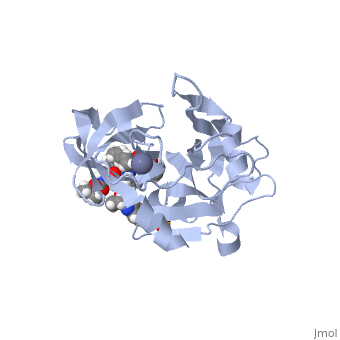Zepatier
From Proteopedia
(Difference between revisions)
| Line 12: | Line 12: | ||
HCV is transmitted exclusively through blood whereupon the virus travels to the hepatocytes of the liver to undergo rapid replication<ref>Tan, S.-L. Hepatitis C viruses: genomes and molecular biology; Horizon bioscience: Wymondham, 2006.</ref>. This results in the inflammation of the liver, leading to decreased function and/or liver failure. HCV induces an immune response within the infected individual which commonly fails to restrict the development of chronicity. For more information on HCV click here [http://www.cdc.gov/hepatitis/hcv/index.htm]. | HCV is transmitted exclusively through blood whereupon the virus travels to the hepatocytes of the liver to undergo rapid replication<ref>Tan, S.-L. Hepatitis C viruses: genomes and molecular biology; Horizon bioscience: Wymondham, 2006.</ref>. This results in the inflammation of the liver, leading to decreased function and/or liver failure. HCV induces an immune response within the infected individual which commonly fails to restrict the development of chronicity. For more information on HCV click here [http://www.cdc.gov/hepatitis/hcv/index.htm]. | ||
| - | While six distinct genotype of HCV were discovered, genotypes 1 is the most prevalent amongst populations and the most difficult to treat. Increased resistance of the virus at the M28, Q30, L31, or Y93 amino acids results in decreased effectiveness of pharmaceuticals against genotype 1. Genotype 1 results from the infection of human lymphoid cells by the virus. Genotype 4 has recently increased in prevalence, resulting in attempts to | + | While six distinct genotype of HCV were discovered, genotypes 1 is the most prevalent amongst populations and the most difficult to treat. Increased resistance of the virus at the M28, Q30, L31, or Y93 amino acids results in decreased effectiveness of pharmaceuticals against genotype 1. Genotype 1 results from the infection of human lymphoid cells by the virus. Genotype 4 has recently increased in prevalence, resulting in attempts to decrease transmission<ref>Tan, S.-L. Hepatitis C viruses: genomes and molecular biology; Horizon bioscience: Wymondham, 2006.</ref>. |
Revision as of 19:06, 4 December 2016
| |||||||||||
References
- ↑ Petrescu, I. O.; Biciusca, V.; Taisescu, C. I.; Alexandru, D. O.; Taisescu, O.; Comanescu, M. V.; Petrescu, F.; Popescu, I. A.; Trasca, D. M.; ForTofoiu, M. C.; Silosi, C. A.; ForTofoiu, M. Histological factors that predict the liver fibrosis in patients with chronic hepatitis C. Rom. J. Morphol. Embryol. 2016, 57, 759-765.
- ↑ 2.0 2.1 Coburn CA, Meinke PT, Chang W, Fandozzi CM, Graham DJ, Hu B, Huang Q, Kargman S, Kozlowski J, Liu R, McCauley JA, Nomeir AA, Soll RM, Vacca JP, Wang D, Wu H, Zhong B, Olsen DB, Ludmerer SW. Discovery of MK-8742: an HCV NS5A inhibitor with broad genotype activity. ChemMedChem. 2013 Dec;8(12):1930-40. doi: 10.1002/cmdc.201300343. Epub 2013 Oct, 14. PMID:24127258 doi:http://dx.doi.org/10.1002/cmdc.201300343
- ↑ Soumana DI, Kurt Yilmaz N, Prachanronarong KL, Aydin C, Ali A, Schiffer CA. Structural and Thermodynamic Effects of Macrocyclization in HCV NS3/4A Inhibitor MK-5172. ACS Chem Biol. 2015 Dec 18. PMID:26682473 doi:http://dx.doi.org/10.1021/acschembio.5b00647
- ↑ Tan, S.-L. Hepatitis C viruses: genomes and molecular biology; Horizon bioscience: Wymondham, 2006.
- ↑ Chevaliez, S.; Pawlotsky, J. M. Virology of hepatitis C virus infection. Best Pract. Res. Clin. Gastroenterol.2012, 26, 381-389.
- ↑ Tan, S.-L. Hepatitis C viruses: genomes and molecular biology; Horizon bioscience: Wymondham, 2006.
- ↑ Tan, S.-L. Hepatitis C viruses: genomes and molecular biology; Horizon bioscience: Wymondham, 2006.
- ↑ National Center for Biotechnology Inforamtion. PubChem Compound Database; CID=71661251, https://pubchem.ncbi.nlm.nih.gov/compound/71661251#section=Chemical-and-Physical-Properties
- ↑ doi: https://dx.doi.org/http
- ↑ Fridell RA, Qiu D, Valera L, Wang C, Rose RE, Gao M. Distinct functions of NS5A in hepatitis C virus RNA replication uncovered by studies with the NS5A inhibitor BMS-790052. J Virol. 2011 Jul;85(14):7312-20. doi: 10.1128/JVI.00253-11. Epub 2011 May 18. PMID:21593143 doi:http://dx.doi.org/10.1128/JVI.00253-11
- ↑ National Center for Biotechnology Information. PubChem Compound Database; CID=44603531, https://pubchem.ncbi.nlm.nih.gov/compound/44603531.
- ↑ Soumana DI, Kurt Yilmaz N, Prachanronarong KL, Aydin C, Ali A, Schiffer CA. Structural and Thermodynamic Effects of Macrocyclization in HCV NS3/4A Inhibitor MK-5172. ACS Chem Biol. 2015 Dec 18. PMID:26682473 doi:http://dx.doi.org/10.1021/acschembio.5b00647
[1] [2] [3] [4] [5] [6] [7] [8] [9] [10]

